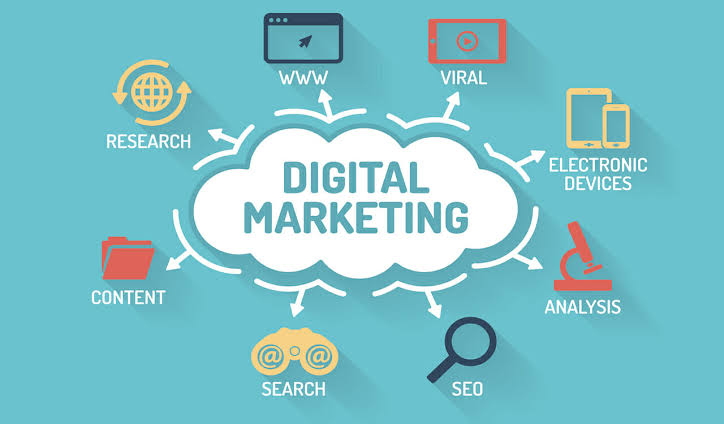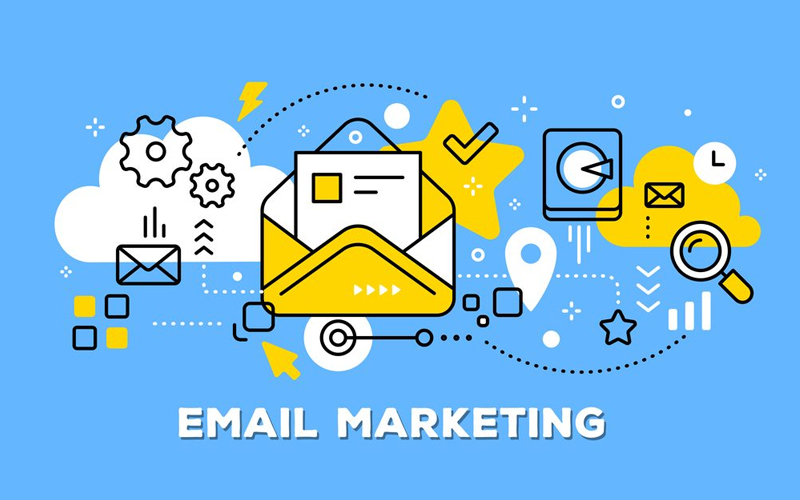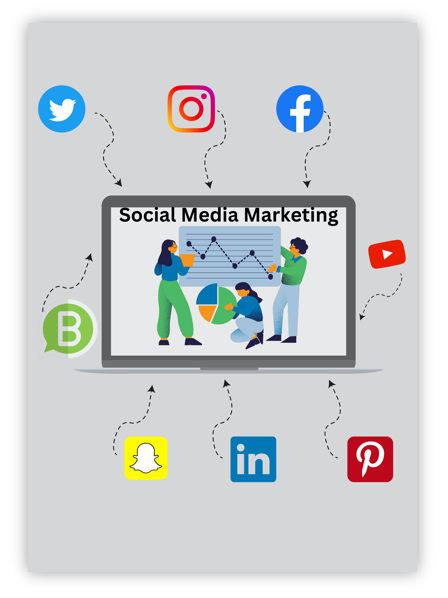

A digital marketing strategy is a set of planned actions performed online to reach specific business goals. In simple terms, this means performing consistent actions at the right time via the most suitable online channels to increase revenue and improve relationships with your audience comprehensive digital marketing strategy is crucial for businesses to maximize their efforts and achieve their goals. These strategies should include 5 main types of digital marketing efforts such as:
- CONTENT MARKETING
- EMAIL MARKETING
- SEO
- PPC
- SOCIAL MEDIA
- AFFILIATE MARKETING
1.COntent marketing:

What is content strategy?

A content strategy is the planning, creating, publication, management, and governance of content. A great content strategy will attract and engage a target audience, meeting their needs while driving business goals.
Why is content marketing important?
Content marketing is a go-to tactic that’s proven to work. Also, it provides a competitive advantage. Take a look at what the data says about content marketing:
- Businesses with belong get 67% more ideas than other companies
- 67% of business-to-business (B2B) marketers stay B2B content marketing increases engagement and the number of leads they generate.
1. Goals and Objectives
- Define Clear Goals: What do you want to achieve with your content marketing? common goals include brand awareness, lead generation, customer engagement, and sales.
- MART Objectives: Ensure correctives are Specific, Measurable, Achievable, Relevant, and time-bond.
2. Audience Research
- Buyer Personas: Develop detailed profiles of your target audience segments, including demographics, interests, and paint points.
- and behaviors.
- Customer Journey Mapping: Understand the stages your audience goes through from awareness to decision making.
3. content AUDIT:
- Evaluate Existing Content: Assess the performance of your current content. Identify what’s working, what’s not, and any gaps
- Customer Journey Mapping: Understand the stages your audience goes through from awareness to decision-making.
4. Content Planning
- Content Themes and Topics: Determine key themes and topics that resonate with your audience and align with your goals.
- Content Calendar: Plan your content creation and publication schedule. include import dates, campaigns, and promotional activities.
5. Content Creation
- Types of Content: Choose a mix of content formats like blog posts, videos, infographics, podcasts, books, and social media posts.
- Quality and Consistency: Focus on creating high-quality content that provides value. maintain a consistent voice and style.
By following these steps and continuously refining your approach, you can develop an effective content marketing strategy that drives meaningful results for your business.
2. EMAIL MARKETING:

Email marketing is a powerful marketing channel, a form of direct marketing as well as digital marketing, that uses email to promote your business’s products or services. It can help make your customers aware of your latest items or offers by integrating it into your marketing automation efforts. It can also play a pivotal digital marketing with lead generation, brand awareness, building relationships or keeping customers engaged between purchases through different marketing emails.

1. Email marketing types and examples:
There are many different types of email marketing. Each one serves a different purpose and takes a different avenue to engage with your audience. We are going to look at some of the many different types so that you can create the best email marketing campaign for your company.
1. Define Goals and Objectives:
- Set Clear Goals: Determine what you want to achieve with your email marketing effectors. common goals include increasing sales, driving website traffic, hurting leads, and enhancing customer retention.
- SMART Objectives: Ensure your objectives are Specific, Measurable, achievable, relevant, and time-bond
2. Build and Segment Your Email List:
- List Building: Use strategies like website sign-up forms, social media promotion, and lead magnets (e.g., eBooks, and webinars) to grow your email list.
- behavior, purchase history, and engagement levels to send more targeted and engagement levels to send more targeted and relevant email
3. Choose the Right Email Marketing Platform:
- Email Service Providers (ESPs): Select a platform that suits your needs, such as Mailchimp, Constant Contact, HubSpot or an active campaign
- Features to Consider: Look for features like automation, personalization, segmentation, analytics, and integration with other tools you use
4. Design Your Email Campaignssign Your Email Campaigns
- Types of Emails: Plan different types of emails, such as newsletters, promotional emails, welcome series, and re-engagement campaigns.
- Email Templates: Use responsive email templates to ensure your emails look good on all maintain a consistent design the alignstent design that aligns with your brand.
5. Craft Compelling Content:
- Subject Lines: Write attention-grabbing subject lines that entice recipients to open the email.
- Email Copy: Create clear, concise, and engaging content. Personalize the message to make it relevant to the recipient.
- Calls to Action (CTAs): Include strong CTAs that guide the recipient toward the desired action, such as making a purchase, downloading a resource, or signing up for an event.
3. SEO:

Search engine optimization (SEO) is the practice of orienting your website to rank higher on a search engine results page (SERP) so that you receive more traffic. The aim is typically to rank on the first page of Google results for search terms that mean the most to your target audience

1. Understand Your Business Objectives
- Align SEO Goals with Business Goals: Ensure your SEO goals sport your overall business objectives, such as increasing revenue, generating leads, or improving your brand.
- Define Key Performance Indicators (KPIs): Determine which KPIs will help you measure the success of you measure the success of your SEO efforts, such as organic traffic, conversion rates, and search engine rankings.
2. Conduct Keyword Research:
- Identify Keywords: Use tools like Google Keyword Planner, SEMrush, Ahrefs, or Moz to find relevant keywords that your target audience is searching for.
- Analyze Competitors: Study your competitors to understand which keywords they are targeting and identify gaps you can exploit.
- Long-Tail Keywords: Focus on long-tail keywords, which are less competitive and more specific, to attract highly targeted traffic.
3. On-Page SEO:
- Meta Descriptions: Write informative and enticing meta descriptions that encourage clicks.
- Header Tags: Use H1, H2, and H3 tags to structure your content and include keywords where relevant.
- URL Structure: create a clean, descriptive URL that includes keywords.
- Content Optimization: Ensure your content is high-quality, informative, and optimized for target keywords. Use keywords naturally and avoid keyword stuffing.
- Internal Linking: Use internal links to connect related content and help search engines understand the structure of your site.
4. Technical SEO:
- Site Speed: Optimize your website’s loading speed by compressing images, leveraging browser caching, and minimizing HTTP requests.
- Mobile-Friendliness: Ensure your website is mobile-friendly and provides a good user experience on all devices.
- Crawlability: Use tools like Google Search Console to check for crawl errors and ensure search engines can easily crawl and index your site.
- Sitemap and Robots.txt: Create and submit a sitemap and properly configure your robot’s text file.
- HTTPS: Secure your website with HTTPS to enhance security and improve ranking.
5. Content Strategy:
- Create High-Quality Content: Develop content that provides value, addresses users, and answers your audience” questions.
- Content Types: Use a mix of content formats such as blog posts, videos, infographics, podcasts, and e-books
- Content Calendar: Plan and schedule your content to ensure consistency and regular updates.
- User Experience (UX): Focus on creating a positive user experience with easy navigation, clear calls to, and engaging visuals.
4. PPC:

pay-per-click is a type of internet marketing that involves advertisers paying a fee each time one of their ads is clicked. Simply, you only pay for advertising if your ad is clicked on. It’s essentially a method of ‘buying’ visits to your site, in addition to driving website visits organically.
Most reports say the average PPC management fee comes out to around 10% to 20% of ad spend. So the amount of money a client devotes to PPC ads has a direct impact on the fee you’ll charge. But there are nuances in the calculation that can nudge your fees up or down.

1. Set Clear PPC Goals:
- Define Objectives: Determine what you want to achieve with your PPC campaigns. Common goals include increasing website traffic, generating leads, boosting sales, and enhancing
- SMART Goals: Ensure your goals are Specific, Measurable, Achievable, relevant, and time-bound.
2. Understand Your Audience:
- Audience Research: Use tools like Google Analytics and Facebook Insights to get data about your target audience’s demographics, interests, and online behavior.
- Buyer Personas: Develop detailed buyer personas to tailor your ad campaigns to your ideal customer.
3. Keyword Research:
- Match Types: Choose appropriate keyword match types (broad match, phare match, exact match, and negative keywords) to control who sees your ads.
- Competitor Analysis: Analyze your competitors’ keywords and ad strategies to identify opportunities and gaps.
4. Choose the Right PPC Platforms:
- Google Ads: all for search ads, display ads, shopping ads, and YouTube ads.
- Bing Ads: useful for reaching an audience on the Bing search network.
- Social Media Ads: Facebook, Instagram, LinkedIn, Twitter, Twitter, and Pinterest offer robust PPC advertising options.
- dtyiConsider platforms like Amazon Advertising for e-commerce or niche or niche networks specific to your industry.
- Other Platforms: Consider platforms like Amazon Advertising for e-commerce or niche networks specific to your industry
5. Create Compelling Ad Copy and Design:
- Ad Copy: Write clear, concise, and compelling ad copy that includes a strong call-to-action (CAT) and relevant keywords.
- Ad Design: Use high-quality images and videos that capture attention and are relevant to your target audience.
- Ad Extensions: Utilized ad extension.
5. social media:

Social media marketing involves using platforms like Facebook, Instagram, Twitter, Linked In, and TikTok to effectively reach a wider audience and communicate with customers. Social media marketing is necessary for any small business marketing strategy and requires a robust plan. Your customers expect engaging content and the ability to communicate with you through direct messaging and comments.

SMAR IDENTIFY Compet1. Define Your Goals
1. Understand Your Audience
- Demographics: age, gender, location, education, occupation.
- Psychographic: interests, values, lifestyle, behavior
- Tools: Use tools like Google Analytics, social media insights, and customer surveys to gather data.
2. Conduct a Competitor Analysis:
- editors: List your main competitors and analyze their social media presence
- SWOT Analysis:· Identify. strengths, weaknesses, opportunities, and threats.
- Benchmarking: Determine the benchmarks for engagement, follower count content type, and posting frequency
3. Choose the Right Platforms:
- Audience Alignment: Choose platforms where your target audience is most active.
- Platform Strengths: Leverage the unique features of each platform.
4. Create Engaging Content:
- Content Types: Images, videos, stories, blogs, info-graphics, live videos
- Content Calendar: Plan your content to ensure consistency.
- User-Generat: Encourage your audience to create content relatedEncourage your audience to create content related your brand.
By following these steps, you can develop a robust social media marketing strategy that helps you achieve your business goals and connect effectively with your audience.
6. AFFILIATE MARKETING:

Affiliate marketing is the process by which an affiliate earns a commission for marketing another person’s or company’s products. The affiliate simply searches for a product they enjoy, then promotes that product and earns a piece of the profit from each sale they make. affiliate marketing means you earn a monetary commission by rewarding a commission for providing a specific result to a merchant or advertiser, be it sales, leads, or downloads.

1. Set Clear Affiliate Marketing Goals:
- Define Objectives: Determine what you want to achieve with your affiliate marketing efforts. Common goals include increasing sales, generating leads, expanding your customer base, and enhancing brand awareness.
- SMART Goals: Ensure your goals are Specific, Measurable, Achievable, relevant, and time-bound.
2. Choose the Right Affiliate Program Model:
- Pay-Per-Sale (PPS): Affiliates ea3. Select an Affiliate Marketing Platform to earn a commission for each sale generated.
- Pay-Per-Click (PPC): Affiliates earn a commission for each click generated.
- Pay-Per-Lead (PPL): Affiliates earn a commission for each lead generation. ((e.g., sign-ups,from submission)
3. Select an Affiliate Marketing Platform:
- Affiliate Networks: Join established affiliate networks like Shareable, CJAffiliate, Tauten Marketing, or Amazon Associates to find and manage affiliates.
- In-House Programs: Develop and manage your affiliate program using tools like posts like affiliated pro, provision or affiliated.
4. Recruit Affiliates:
- Identify Potential Affiliates: Look for influencers, bloggers, content creators, and websites that align with your brand and target audience.
- Outreach: Reach out to potential affiliates with a compelling offer and details about your affiliated program.
- Onboarding: Provide affiliates with all the necessary information, resources, and tools to get started, including tracking links, banners, and promotional materials.
5. Provide High-Quality Marketing Materials:
- Creatives: Supply affiliates with professionally designed banners, images, and videos that they can use to promote your products.
- Content: Provide ready-made content such as product descriptions, reviews, email templates, and blog posts.
- Brand Guidelines: Ensure affiliates adhere to your brand’s guidelines to maintain constancy and protect your brand reputation.
